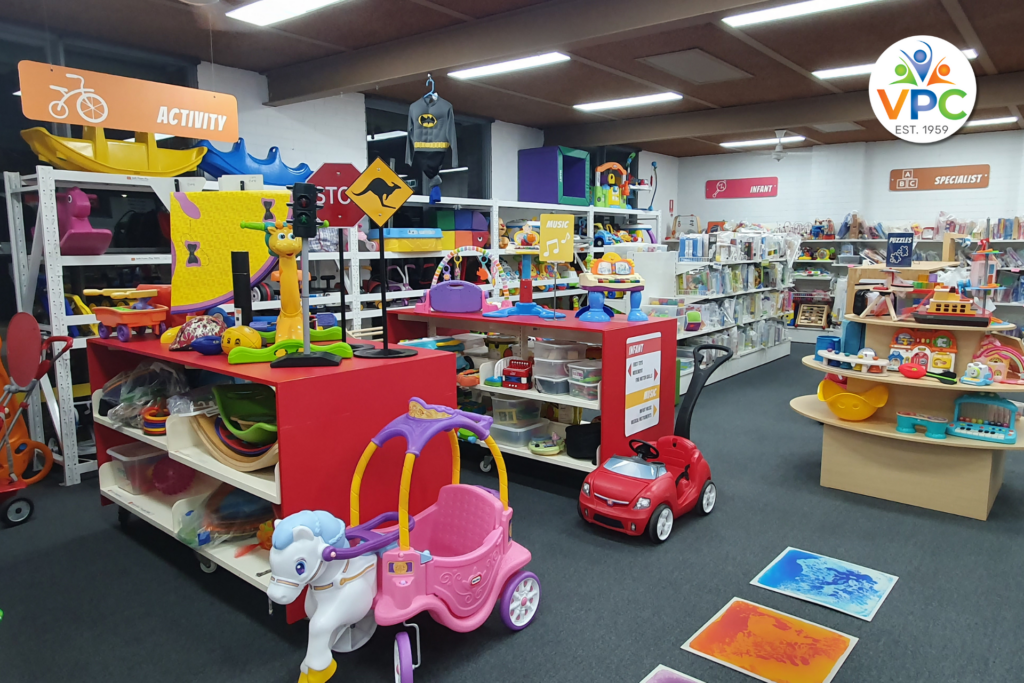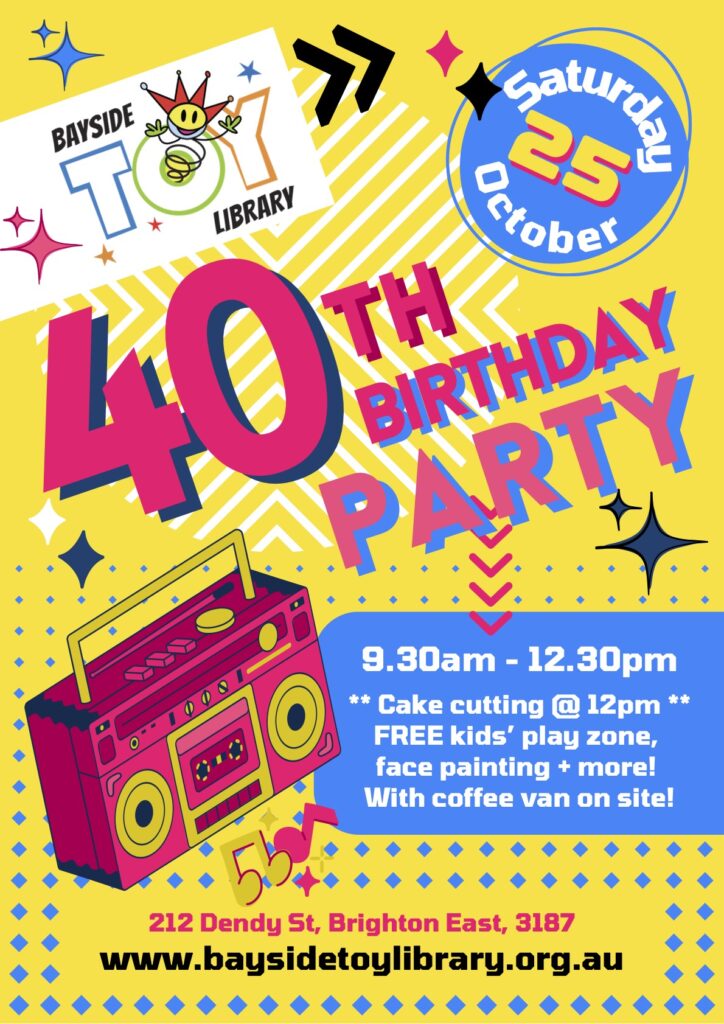
TEACHING KIDS SUSTAINABILITY THROUGH PLAY: HOW TOY LIBRARIES MAKE LEARNING FUN
Raising children today is complex. We all hope our little ones grow up to be happy, healthy, responsible and environmentally aware, but how do we instil these values from a young age?
One of the simplest, most practical (and fun!) ways to introduce sustainability and responsibility to kids is through the use of toy libraries.
Celebrating their 40th Anniversary in 2025, Bayside Toy Library in Brighton East, Victoria, has been providing local families with affordable access to thousands of quality toys, games and puzzles for four decades – encouraging sustainable habits and creating lifelong memories.
What Is a Toy Library?
A toy library works much like a traditional book library, except members borrow toys instead of books. With a modest annual membership fee and often a small volunteer commitment, families can borrow a rotating selection of toys, puzzles, games, and dress-ups for a set period.
The concept is simple: borrow, play, return, repeat.
6 Reasons Why Toy Libraries are the Smartest Way to Play
Toy libraries aren’t just about toys. They shape how children learn, connect, and care for the planet.
Here are six reasons why toy libraries are one of the smartest (and most sustainable) ways to play:
1. Affordable Access to Quality Toys
Australian families invest heavily in play. The average Aussie family spends $423 annually on toys and games[i], with most households owning in excess of 100+ toys.[ii]
Toy libraries give families affordable access to thousands of quality toys & games for a fraction of this cost, with toy library memberships often starting as low as $40 per year.[iii]
2. Supporting Sustainability
Toys are the most plastic intensive consumer goods in the world[iv]. Unfortunately, around 51% of new toys sold in Australia become waste within a year[v], and an estimated 87,000 tonnes goes to landfill annually.[vi]
By contrast, Toy libraries extend the life of toys, teaching children to share, reuse and reduce waste.
3. Access to Large, Bulky & Expensive Toys Without the Cost or Hassle
Toy libraries solve two of the biggest challenges for families: storage space and cost of living.
Items such as large ride-on cars, expensive STEM kits, seasonal water tables, and bulky soft foam climbing sets all offer rich play experiences but are costly and take up space. Toy libraries let families borrow these items without having to buy, store, or discard them later – making play more diverse and exciting without costing a fortune.
“By borrowing rather than buying, children experiment with toys and activities they might not otherwise experience, while families save space, money, and reduce waste.”
4. Child Development & Learning Through Play
Children learn best through play.[vii] Their innate curiosity and propensity for exploring and making sense of the world around them flourishes when they are provided with access to a broad range of quality play items and experiences.
Toy libraries carefully curate their collections to support all aspects of child development – from gross and fine motor skills to building creativity, confidence, problem-solving, literacy & numeracy, oral vocabulary, dramatic play, emotional regulation, and social skills.
5. Community and Connection
Toy libraries are more than lending services – they’re community hubs. Families come together to share experiences, meet other parents, and support each other’s children to learn and thrive.
Many families visit weekly, and for countless children the toy library becomes a favourite place to explore. Unlike toy stores where kids are often told “don’t touch”, toy libraries provide a welcome opportunity for parents to say “yes” – fostering independence, confidence, and connection.
This stress-free environment also provides respite for parents and carers from the sometimes lonely and isolating role of caring for young children, where perhaps you just want, or need, to chat to another adult who understands what you’re going through, whilst your little one plays happily and safely in an engaging and welcoming environment.
6. Circular Economy in Action
Toy libraries embody circular economy principles: reuse, reduce waste, and make resources accessible to the wider community[viii].
At Bayside Toy Library, each toy is borrowed about 15 times per year and lasts up to a decade, saving more than half a million toys from landfill every ten years.
By showing children that sharing and reusing is normal, toy libraries raise a generation that values community, creativity, and care for the planet.
How to Join a Toy Library
Joining a toy library is simple:
1. Find your local toy library – use Toy Libraries Australia’s online directory here.
2. Sign Up – Choose a membership tier based on how many toys you’d like to borrow, and consider volunteering for a few hours each year for a discounted membership fee.
3. Borrow Toys – Select items suited to your child’s age, interests, and developmental stage.
4. Return and Rotate – At the end of the loan period, clean and return your toys, ready for the next family.
5. Get Involved – Volunteer, donate, or join in the free community events at your local toy library, such as Stay & Play sessions or Community Open Days.
The Takeaway for Parents
Toy libraries aren’t just about toys – they’re about values, learning, and community. They teach empathy, resourcefulness, and respect for self, others, and the environment while giving families affordable access to a range of high-quality educational toys.
By borrowing, sharing, and caring for toys, children learn sustainable habits early, and families save money, reduce waste, and connect with their community.
Most of all though, Toy libraries turn playtime into a joyful family experience that creates lifelong childhood memories of laughter, fun and play.
To discover the benefits for yourself, find your local toy library today at www.toylibraries.org.au/find-a-toy-library.

References
[1] Choosi Cost of Kids Report (2023), https://www.choosi.com.au/documents/the-cost-of-kids-report-whitepaper.pdf
[1] McCrindle Research – Generation Z (2024) – Australian household toy spending statistics – https://generationz.com.au/articles/consumers/ and https://mccrindle.com.au/
[1] Bayside Toy Library – Official website and membership information – https://baysidetoylibrary.org.au/membership/
[1] United Nations 2014 Environment Programme Report, UNEP (2014) Valuing Plastics: The Business Case for Measuring, Managing and Disclosing Plastic Use in the Consumer Goods Industry, Julie Raynaud (Trucost) (2014), https://wedocs.unep.org/bitstream/handle/20.500.11822/25302/Valuing_Plastic_ES.pdf
[1] Australian Circular Economy Hub, Sustainability Victoria Funds Ten Innovative Circular Economy Projects, Tamanna Wadhwani (2023)
https://acehub.org.au/news/sustainability-victoria-funds-ten-innovative-circular-economy-projects
[1] Circular Economy Action Plan and Roadmap for Toys – Australian Toy Association and Sustainability Victoria – prepared by Shlomit Kuttner at Equilibrium OMG pty Ltd, for the Australian Toy Association (2022), https://assets.sustainability.vic.gov.au/susvic/Circular-Economy-Action-Plan-and-Roadmap-for-Toys-Australian-Toy-Association-and-Sustainability-Victoria.pdf
Sallyanne Hunter is the Manager at Bayside Toy Library in Victoria, which provides local families with affordable access to over 4,000 toys, games and puzzles. With a 20-year career spanning toy, product and retail design solutions for global brands in Australia and the USA, Sallyanne swapped corporate life for the joys of play in 2019. She now helps kids – and their parents – to laugh, learn and share, teaching families and future generations how toy libraries make sustainability seriously fun.

